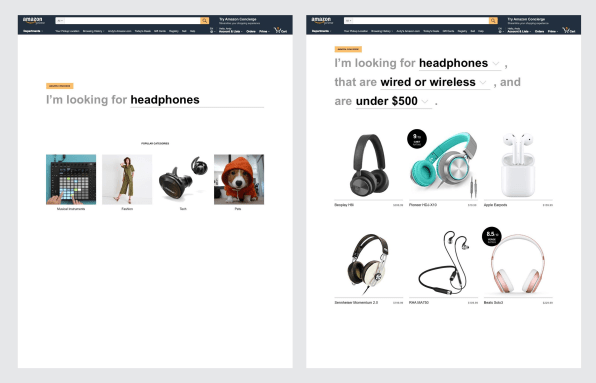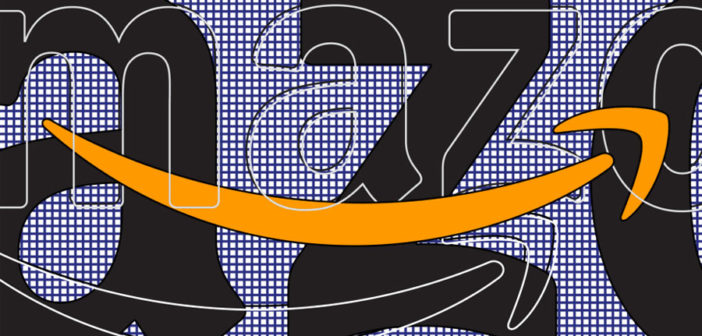Amazon is woefully lacking when it comes to user-centered design. So Co.Design asked a top design studio to rethink it.
If you’ve ever searched for a product and felt like Amazon’s results were serving Amazon’s business goals more than your own, you aren’t alone. A recent Forrester survey found that while consumers appreciate its speed and convenience, they don’t feel valued as Amazon customers. Who can blame them? Like Facebook and Google, Amazon is highly impersonal. Powered by algorithms the consumer can’t see, it prioritizes products that aren’t necessarily the cheapest, or most highly rated, or easiest to attain, nudging our behaviors toward end goals that aren’t necessarily our own, but belong to Amazon or its partners.
These are dark patterns that undermine Amazon’s brand and value to consumers. The ensuing lack of trust isn’t just a problem for consumers wanting a good deal; Forrester went so far as to say that its perceived lack of humanity is an “Achilles’ heel” for Amazon, a competitive vulnerability in its seemingly untouchable empire.
I wondered what Amazon would look like if it were redesigned as a more transparent, trusted, and even human service. So Co.Designenlisted the award-winning digital studio Upstatement–which has built sites for MIT, Harvard, Salesforce, and Microsoft–to redesign the retailer. Upstatement delivered two concepts that are each anchored in the idea that Amazon should reposition itself not as a deal warehouse but a trusted advisor or concierge. You’ll notice that these concepts still look and feel much like Amazon of today.
“We tried to work within the current site and aesthetic. We weren’t trying to make a concept car,” says principal Mike Swartz. “We’re not designing a new product; we’re trying to remake the core Amazon experience.
BRING IN THE INFLUENCERS WITH “AMAZON CONCIERGE”
Right now, Amazon is responsible for what you see on its site and why. It recommends products on your home page. It recommends search results. Theoretically, there are all sorts of ways that fine print, and mini infographics could disclose why or how Amazon mined your data or optimizes profits to make those decisions, but Upstatement has a simpler idea: Amazon Concierge. It’s essentially the editorial arm of Amazon, populated by media companies and influencers, that would recommend products.
“We think part of the way to make Amazon feel more human is by bringing in humans,” says Swartz. “Not by Amazon being the one responsible for all products, but by using it as a world that connects you to people who can lead you to good decisions.”
Upstatement imagines you might follow people on Amazon much as you do Instagram or Twitter–maybe a pro photographer for camera gear, or perhaps a celebrity if you were interested in fashion or beauty. Platforms like Instagram are converging around retail with shoppable posts, and each of its influencers is essentially providing an aspirational feed of recommended (often sponsored) products already. Amazon could cut out the social media middleman and just host it on its own site.
For Amazon, Concierge wouldn’t just be about embracing influencer culture; it’d be a means to bringing earnest, objective recommendations closer to Amazon, too. Already, much of the media world reviews and recommends Amazon products through paid affiliate links, which Amazon could just fold into the service itself.
“The entire buying ecosystem on Amazon includes sites like the Wirecutter,” adds Upstatement principal Tito Bottitta, pointing out that affiliate links already financially incentivize the creation of this content, and could continue to in this new design. “We wondered, what if we brought that closer to Amazon? Having that stamp on things feels like it mitigates Amazon the brand showing you stuff.”
Indeed, the idea actually has a lot of parallels to what you see at supermarkets or electronics stores today. Often, the wine aisle will have Wine Spectator ratings on various bottles, or some Best Buy electronic will highlight a CNET review on the box. Amazon has long depended on itself and its users to validate products. But professional opinions would be refreshing.

LET USERS NUDGE THE ALGORITHM WITH SMART SEARCH
Searching on Amazon today involves typing something into a white box and getting a long list of results. Some are sponsored. Others are just there, ordered by a logic that no one understands. You can prune those results with check boxes for Prime, or sorting by price. But Upstatement imagined another way called Smart Search.
Smart Search is basically a more specific search that you control with a plain language sentence. Instead of searching for “headphones,” you could specify you wanted “headphones” that are “wired or wireless” and cost “under $500.”
“We thought it was a better positioning for the [search]algorithm,” says Bottitta. “We know it’s there, but when you feel its effects with no control over it, that’s when you get rubbed the wrong way.”
Ideally, Smart Search would offer more tailored search parameters than what Amazon offers with its checkbox navigation bar today, getting into real specifics that would change by product and product category, ranging from color to weight to style. But even if it didn’t, there is something appealing about this front-end, conversational control. It simply sounds like Amazon is listening to the entirety of what the customer wants, rather than cutting them off at the word “headphones” and listing 1,000 results. And by asking the customer for more information, Amazon is turning its silent data tracking into a more friendly conversation, which reduces the creep factor of a suggestion that’s too good.
“The idea here is, even though Amazon can figure out I just had a kid or a cat, maybe they shouldn’t,” says Bottitta. “Maybe they should get more information from me [directly]to tune the algorithm before they start searching stuff.”
As a final touch, the team also suggests that those ratings from its conceptual Amazon Concierge could be folded into the Smart Search results as well, highlighting those Wirecutter picks, or even products your friends liked, to prioritize and contextualize the results.
Ultimately, Upstatement acknowledges that Amazon is a massive platform, with various corners that are constantly experimenting with different types of curation. “Amazon is so big, I don’t know that there’s some land or territory on Amazon we haven’t explored that’s trying some of this stuff. If there is, we haven’t found it,” says Swartz with a laugh. “But part of the power of the idea is putting it in the right place.”
–
This article first appeared in www.fastcodesign.com
Seeking to build and grow your brand using the force of consumer insight, strategic foresight, creative disruption and technology prowess? Talk to us at +9714 3867728 or mail: info@groupisd.com or visit www.groupisd.com

